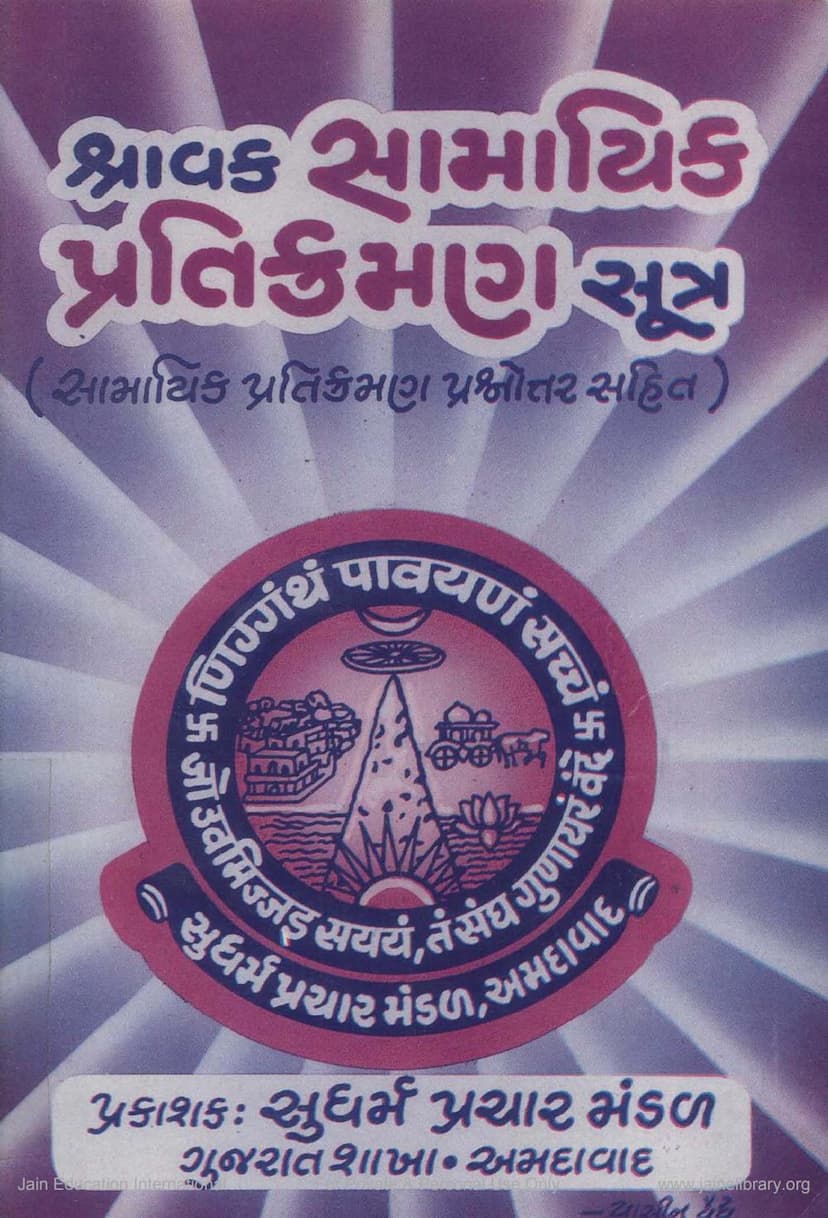Shravaka Samayika Pratikramana Sutra
Added to library: September 2, 2025

Summary
Here's a comprehensive summary of the "Shravaka Samayika Pratikramana Sutra" by Sudharma Prachar Mandal, Ahmedabad, in English:
Book Title: Shravaka Samayika Pratikramana Sutra (with meaning, questions, and rituals) Publisher: Sudharma Prachar Mandal (Gujarat Branch), Ahmedabad
This book is a Jain text focused on the practices and prayers for lay followers (Shravakas) during their spiritual observance, particularly the "Samayika" (equanimity) and "Pratikramana" (repentance and confession).
Key Aspects and Content:
-
Purpose: The book serves as a guide for lay Jains to perform their daily or periodic spiritual practices, which are essential for accumulating merit and purifying the soul. It aims to help devotees understand the significance and correct recitation of these sacred texts.
-
Structure and Content:
- Introduction & Publisher's Note (Pages 2-5): The initial pages detail the activities of the Sudharma Prachar Mandal, highlighting their commitment to promoting Jainism through various means:
- Sending spiritual guides to areas without Chaturmas observances.
- Organizing training camps, teacher conventions, and devotee conferences.
- Conducting annual Jain religious examinations.
- Recognizing meritorious students and women's groups.
- Expressing gratitude to supporters and requesting guidance.
- Dedication and Acknowledgement (Pages 6-9): The book acknowledges and expresses deep gratitude to key individuals, namely Shri Navnitbhai C. Patel and Shri Bharatbhai M. Sheth, for their generous financial contributions and unwavering support towards the publication and dissemination of Jain literature. Their dedication to spreading the teachings of the Jinavani and their philanthropic activities for the Jain community are highlighted.
- The Sutra Texts (Pages 11 onwards): The core of the book comprises the recitation of various essential Jain sutras (prayers and scriptures) relevant to Shravaka practices. This includes:
- Samayika Sutra (Page 11): Defines Samayika as aligning the soul with discipline, restraint, and penance, and maintaining equanimity towards all living beings (sentient and non-sentient). It emphasizes the renunciation of sinful actions (Savādya yoga) and engagement in virtuous actions (Nirvādya yoga).
- Recitation Guides (Pages 12-16): A significant portion of the book is dedicated to "Ucchār Shuddhi Darshan" (Guidance on Pronunciation Purity). This section meticulously guides the reader on the correct pronunciation of specific words and syllables within the sutras, addressing common errors and emphasizing the importance of accurate recitation to avoid mistakes and deepen spiritual understanding. It covers key sutras like Namaskāra Sutra, Guruvandana Sutra, Ālochanā-Īryāpathika Sutra, Tasya Uttari Sutra, Logassa Sutra, Karemi Bhante Sutra, and Shakrastava Sutra.
- Detailed Sutra Explanations (Pages 17-49): The book then presents the meaning and explanation of each sutra, including:
- Namaskāra Sutra (Page 17): Explains the meaning of the Panch Parameṣṭhi mantras (Namo Arihantāṇaṁ, Namo Siddhāṇaṁ, Namo Āyariyāṇaṁ, Namo Uvajjhāyāṇaṁ, Namo Loe Savvasāhūṇaṁ).
- Guruvandana Sutra (Page 18): Details the rituals of bowing to the Guru, emphasizing the importance of respectful salutation.
- Ālochanā-Īryāpathika Sutra (Pages 18-22): This is a core part of Pratikramana, where one confesses and repents for unintentional harm caused to living beings through actions of mind, speech, and body, especially while walking. It lists various categories of living beings and the ways harm might have occurred.
- Tasya Uttari Sutra (Pages 20-21): This section deals with "Kāyotsarga" (abandonment of bodily activities) for atonement, listing various acceptable and unacceptable interruptions to Kāyotsarga.
- Āgāra Sutra (Page 21): Lists permissible exemptions during Kāyotsarga (like sneezing, coughing, etc.).
- Chaudviśati Stava Sutra (Logassa Sutra) (Pages 22-26): Recitation of praises for the 24 Tirthankaras, acknowledging their virtues and seeking their blessings.
- Karemi Bhante! Sutra (Pages 26-27): A pledge of Samayika, renouncing sinful actions and committing to virtuous ones.
- Shakrastava Sutra (Pages 27-30): An elaborate praise of the qualities of Arihants and Siddhas, highlighting their path to liberation.
- Pratikramana Sutra (Pages 50-51): Explains the benefit of Pratikramana in preventing vows from becoming flawed and stopping the influx of karma.
- Samayika Adhyayana (Page 39): A detailed explanation of Samayika and its benefits, including the cessation of new karma and the destruction of past karma, leading to liberation.
- The Six Āvaśyakas (Pages 37-156): The book systematically explains and presents the meaning of the six essential daily duties (Āvaśyaka) for a Jain householder:
- Samayika: Equanimity, renunciation of sinful activities.
- Chatuvīśati Stava (Logassa): Praise of the 24 Tirthankaras.
- Vandana: Bowing to the Gurus.
- Pratikramana: Repentance and confession of faults.
- Kāyotsarga: Standing still, bodily austerity.
- Pachakhana: Vows and renunciations.
- Detailed Explanations of Vows (Pages 58-118): It elaborates on the 12 vows (5 Anuvratas, 3 Gunavratas, 4 Shikshavratas) undertaken by lay Jains, explaining their meaning, transgressions (Atichara), and significance. This includes vows related to non-violence, truthfulness, non-stealing, celibacy, and non-possession, as well as supporting vows.
- Question and Answer Format (Pages 168-258): A significant portion of the book is dedicated to a comprehensive Q&A section covering various aspects of Samayika, Pratikramana, Namaskara Mantra, and the vows. This interactive format aims to clarify doubts and deepen the understanding of the reader. It covers the meaning of terms, benefits of practices, specific rules, and philosophical underpinnings.
- Introduction & Publisher's Note (Pages 2-5): The initial pages detail the activities of the Sudharma Prachar Mandal, highlighting their commitment to promoting Jainism through various means:
-
Emphasis on Purity and Practice: The book strongly emphasizes the correct pronunciation, understanding of meanings, and sincere intention behind these rituals. It guides the practitioner to perform these actions with devotion and mindfulness.
-
Target Audience: Primarily intended for Jain lay followers (Shravakas and Shravikas) who wish to engage in regular spiritual practices like Samayika and Pratikramana. It also serves as a valuable resource for students and those seeking to understand Jain rituals.
Overall, the "Shravaka Samayika Pratikramana Sutra" is a comprehensive and practical manual designed to facilitate the spiritual journey of Jain householders by providing clear guidance on performing essential rituals, understanding their significance, and fostering a deeper connection with Jain principles.